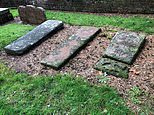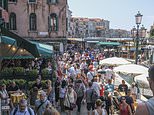
Experts have hailed a ‘major discovery’ in Staffordshire – the identification of eight Knights Templar graves – and say ‘many more’ could be hidden around England.
Historian Edward Spencer Dyas said he made the Da Vinci Code-style revelation at St Mary’s Church in the village of Enville, west of Birmingham.
He thinks the graves can be identified as belonging to Knights Templar members due to the appearance of the clan’s symbols on the headstones.
Knights Templar was a powerful and wealthy military organisation provided safety to protect pilgrims in the Holy Land in the 12th century.
They were founded around AD 1119 – two decades after the Crusaders captured the holy city of Jerusalem from Muslim control – but were disbanded by the pope in 1312 after false accusations of heresy.
Edward Spencer Dyas made the Da Vinci Code-style discovery at St Mary’s Church in Enville, Staffordshire. He first discovered three 800-year-old medieval tombs belonging to members of the ancient order in the churchyard in 2021 and has now discovered five more graves. Mr Dyas believes the medieval building could be the most nationally important Templar churches in the country due to its links to William Marshall
The Knights Templar, which had chapters across Europe, including in Britain, were known for their role in the Crusades and as one of the Middle Ages’ most powerful and wealthy religious organisations
Based on the finding, Mr Dyas believes St Mary’s could be one of the most nationally important Templar churches in the country.
Tony McMahon, a historian, author and Templar expert, called it a ‘major discovery’ because there aren’t many known Templar graves in existence.
He thinks the relevance of the graves has remained unknown for around 500 years.
‘It seems that these graves were recorded in the 16th century and then forgotten,’ he told MailOnline.
‘It’s thanks to the enduring interest in this mysterious order of knights that they have been uncovered again.
‘It does beg the question – if Enville has revealed its Templar dead, how many more graves around England are lying under layers of clay?’
St Mary’s Church could have been one of hundreds of Templar churches in England, McMahon said, adding that members would have been buried with the order’s sacred insignia on their tombstones.
‘Some of them may have seen active duty in Jerusalem and Acre fighting the Saracens while others might not have made it, succumbing to diseases like plague,’ he told MailOnline.
Susie Hodge, historian and author of ‘Secrets of the Knights Templar’, said these ‘could be Templar graves’.
‘Enville is an old village and so is the church,’ she told MailOnline. ‘There may have been other Templar buildings nearby [but] not enough research has been undertaken yet.’
Dr Matteo Borrini, an archeologist at Liverpool Moores University, said further study of the graves could give more information about those buried and whether they were truly knights.
‘Regarding the possibility to find a real Templar grave, historical records and analysis of the archeological evidence can give the final answer,’ he told MailOnline.
‘Definitely it is possible to find them in an hypothetical scenario.’
Depiction of Jacques de Molay, last Grand Master of the Knights Templar (he died in 1314 when sentenced to death)
Pictured, St Mary’s Church in Enville, Staffordshire, close to the A458 road and just west of Birmingham
This map above shows where St Mary’s Church in Enville is in Staffordshire – with outskirts of Birmingham to the west
Who were the Knights Templar?
The Knights Templar were a mysterious holy militia that sprang up in the 12th century.
The medieval order were known for their role in the Crusades and as one of the Middle Ages’ most powerful and wealthy religious organisations.
A unique combination of knight and monk, the Knights Templar was made up of devout Christians tasked with providing safety to pilgrims to Jerusalem.
In 1129, the Knights were officially recognised by the Pope and by 1180 there were some 600 of them in Jerusalem, Tripoli and Antioch.
By the end of the 12th century there were thousands of Knights Templar, who accumulated considerable land, castles and spoils taken in battle.
They even bankrolled Henry II on his crusades.
The Knights Templar were a mysterious holy militia that sprang up in the 12th century (artist’s impression)
Some sources portray Knights Templar as fictional, but there is no doubt of their existence, according to Dr Borrini.
‘Even if the novels and movies portrayed them as a legendary figure, they were an historical reality created around 1119 and formally disbanded in 1312,’ he told MailOnline.
‘Documents such as the Chinon Parchment (dated 17-20 August 1308) prove not only the existence but also the charges and trial for heresy against them.’
St Mary’s Church, on the outskirts of the Black Country, was built in the early 12th century at a time when the Templars were creating Preceptories – a type of monastery – around Britain.
Each of the graves uncovered by Mr Dyas features a Templar cross within double circles in a standard Templar design.
Mr Dyas believes the church was ‘under the patronage of the Templars’ and was built thanks to Templar financing.
But not all experts seemed entirely convinced the graves offer proof of a Knights Templar stronghold at the site.
Helen Nicholson, Emerita Professor of medieval history at Cardiff University, said ‘a cross alone is not enough to show that a tomb was connected to the Templars’.
‘Those are not necessarily Templar crosses,’ she told MailOnline, adding that the order had ‘no standard design’ for its insignia.
‘The Templars did not use a distinctive cross – their crosses had four arms the same length, but otherwise varied.’
Professor Nicholson also pointed to a lack of available evidence that there ever were Templars at Enville.
‘The Templars were disbanded by the pope in 1312 after false accusations of heresy,’ she said.
‘In January 1308, King Edward II of England had all the Templars in England arrested as a result of those false accusations, and had inventories made of all their property.
‘He then appointed officials to administer the properties and send all the profits to his treasury.
‘Many of the records that his officials produced still exist and are in the National Archives of the UK at Kew.
‘A few years ago I transcribed the records for Staffordshire – Enville isn’t mentioned at all.’
One of the graves at St Mary’s Church identified as Templar by historian Edward Spencer Dyas
Each of the graves he has uncovered features a Templar cross within double circles in a standard Templar design. One also includes a Crusader cross, suggesting the knight was both a Templar and a Crusader of the ancient military order
The relevance of the church to Knights Templar may require more investigation, but more certain is England’s place in the order’s history.
McMahon said the Templars were a ‘big deal’ in England as well as other countries around Europe, but their initiation rites and ceremonies were shrouded in mystery and scandal.
‘They set up what were called “preceptories” funding their military operations in the Middle East,’ he told MailOnline.
‘These were like medieval agri-businesses with farms, dairies, workshops, and of course a place of worship at the centre.
‘England was of major importance to the Templars – their English headquarters was in what is now the Holborn area of London.
‘In fact, their first church in the capital was under what is now a modern office block called Southampton Buildings.
‘You can still see their round church nearby – modelled on the Holy Sepulchre in Jerusalem on the exact spot where Christ was crucified and his tomb is also located.’
WHAT WERE THE CRUSADES?
The Crusades were a series of religious wars fought between 1095 and 1291, in which Christian invaders tried to claim the near East.
It’s known that nobility led the Crusades, but historical records lack details of the ordinary soldiers who travelled to, lived and died in the near East.
Pope Urban II started the First Crusade (1096–1102) in order to aid the Christian Byzantine Empire, which was under attack by Muslim Seljuk Turks.
Europeans captured Jerusalem in 1099 as a result and Muslims quickly unified against the Christian invasion.
Muslims firmly controlled Jerusalem by 1291 and it remained in Islamic hands until the twentieth century.
The Crusades set the stage for several religious knightly military orders, including the Knights Templar, the Teutonic Knights, and the Hospitallers.
These groups defended the Holy Land and protected pilgrims travelling to and from the region.
The Crusades were a series of religious wars fought between 1095 and 1291, in which Christian invaders tried to claim the near East. It’s known that nobility led the Crusades, but historical records lack details of the ordinary soldiers (file photo)
Source link
CHECK OUT: Top Travel Destinations
READ MORE: Travel News



